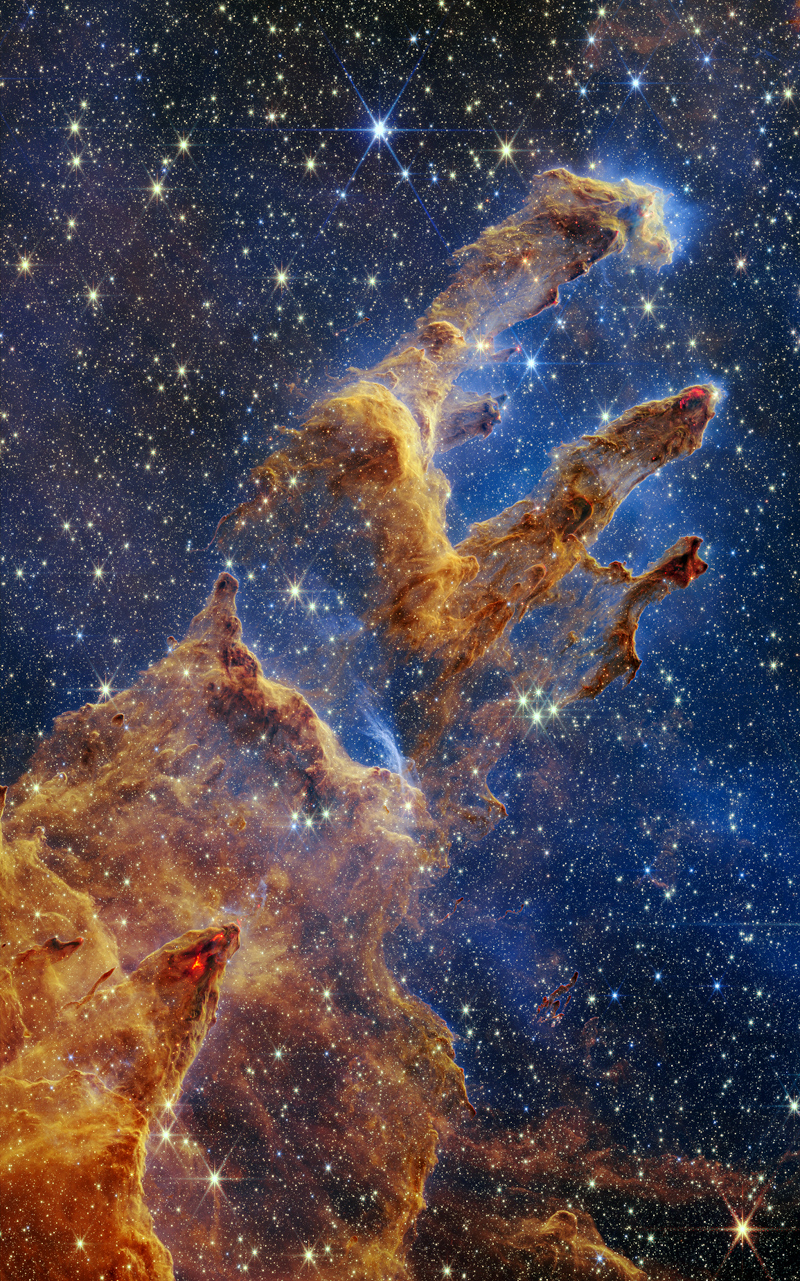20. October 2022
創生之柱

探索宇宙1!逐工會揀一幅無仝款 ê 影像抑是相片,𤆬你熟似咱這个迷人 ê 宇宙,閣有專業天文學者2為你解說3。
- 原始文章:Pillars of Creation
- 影像來源:科學:NASA, ESA, CSA, STScI, NIRCam;資料處理:Joseph DePasquale (STScI), Anton M. Koekemoer (STScI), Alyssa Pagan (STScI)
- 台文翻譯:An-Li Tsai (NCU)
[漢羅] 創生之柱
Hubble 太空望遠鏡 上有名 ê 一張相片 是:創生之柱。 伊是鴟鴞星雲 M16 內底,ùi 冷氣體塗粉組成–ê、1 光年長–ê 恆星形成柱。 毋過這張是 James Webb 太空望遠鏡 ê NIRCam 影像,有通看著 Hubble 進前看袂著 ê 部份,包括 tī 這个有名 ê 恆星托兒所內底,看著較濟細節 kah 較深空 ê 景色。 佇 Webb 近紅外線景色內底上特別–ê,是佇雲柱上尾節 ê 紅色發射線。 佇遐 ê 物質當咧進行重力崩塌,未來會形成恆星。 鴟鴞星雲 離咱有 6500 光年遠。 這个大閣光 ê 發射星雲 tùi 雙筒千里鏡抑是細台天文望遠鏡來講,是真好揣 ê 目標。 M16 就佇咱銀河盤 ê 方向,遐是天頂厚星雲 ê 所在,就佇 分做兩爿–ê 巨蛇座尾溜遐。
[POJ] Chhòng-seng chi Thiāu
Hubble Thài-khong-bōng-oán-kiàⁿ siōng ū-miâ ê chi̍t tiuⁿ siòng-phìⁿ sī: Chhòng-seng chi Thiāu. I sī Ba̍h-hiō-seng-hûn M16 lāi-té, ùi léng khì-thé thô͘-hún cho͘-sêng–ê, 1 kng-nî tn̂g–ê hêng-chhiⁿ hêng-sêng thiāu. M̄-koh chit tiuⁿ sī James Webb Thài-khong-bōng-oán-kiàⁿ ê NIRCam iáⁿ-siōng, ū-thang khòaⁿ-tio̍h Hubble chìn-chêng khòaⁿ bē tio̍h ê pō͘-hūn, pau-koat tī chit ê ū-miâ ê hêng-chhiⁿ thok-jî-só͘ lāi-té, khòaⁿ-tio̍h khah chōe sè-chiat kah khah chhim-khong ê kéng-sek. Tī Webb kīn âng-gōa-sòaⁿ kéng-sek lāi-té siōng te̍k-pia̍t–ê, sī tī hûn-thiāu siōng bóe-chat ê âng-sek hoat-siā-sòaⁿ. Tī hiah ê bu̍t-chit tng leh chìn-hêng tiōng-le̍k pang-lap, bī-lâi ē hêng-sêng hêng-chhiⁿ. Ba̍h-hiō-seng-hûn lī lán ū 6500 kng-nî hn̄g. Chit ê tōa koh kng ê hoat-siā-seng-hûn tùi siang-tâng chhian-lí-kiàⁿ ia̍h-sī sè tâi thian-bûn bōng-oán-kiàⁿ lâi kóng, sī chin hó chhōe ê bo̍k-piau. M16 to̍h tī lán Gîn-hô-pôaⁿ ê hong-hiòng, hiah sī thiⁿ-téng kāu seng-hûn ê só͘-chāi, to̍h tī pun chò nn̄g-pêng–ê Kū-siâ-chō bóe-liu hiah.
[KIP] Tshòng-sing tsi Thiāu
Hubble Thài-khong-bōng-uán-kiànn siōng ū-miâ ê tsi̍t tiunn siòng-phìnn sī: Tshòng-sing tsi Thiāu. I sī Ba̍h-hiō-sing-hûn M6 lāi-té, uì líng khì-thé thôo-hún tsoo-sîng–ê, 1 kng-nî tn̂g–ê hîng-tshinn hîng-sîng thiāu. M̄-koh tsit tiunn sī James Webb Thài-khong-bōng-uán-kiànn ê NIRCam iánn-siōng, ū-thang khuànn-tio̍h Hubble tsìn-tsîng khuànn bē tio̍h ê pōo-hūn, pau-kuat tī tsit ê ū-miâ ê hîng-tshinn thok-jî-sóo lāi-té, khuànn-tio̍h khah tsuē sè-tsiat kah khah tshim-khong ê kíng-sik. Tī Webb kīn âng-guā-suànn kíng-sik lāi-té siōng ti̍k-pia̍t–ê, sī tī hûn-thiāu siōng bué-tsat ê âng-sik huat-siā-suànn. Tī hiah ê bu̍t-tsit tng leh tsìn-hîng tiōng-li̍k pang-lap, bī-lâi ē hîng-sîng hîng-tshinn. Ba̍h-hiō-sing-hûn lī lán ū 6500 kng-nî hn̄g. Tsit ê tuā koh kng ê huat-siā-sing-hûn tuì siang-tâng tshian-lí-kiànn ia̍h-sī sè tâi thian-bûn bōng-uán-kiànn lâi kóng, sī tsin hó tshuē ê bo̍k-piau. M6 to̍h tī lán Gîn-hô-puânn ê hong-hiòng, hiah sī thinn-tíng kāu sing-hûn ê sóo-tsāi, to̍h tī pun tsò nn̄g-pîng–ê Kū-siâ-tsō bué-liu hiah.
[English] Pillars of Creation
A now famous picture from the Hubble Space Telescope featured these star forming columns of cold gas and dust light-years long inside M16, the Eagle Nebula, dubbed the Pillars of Creation. This James Webb Space Telescope NIRCam image expands Hubble’s exploration of that region in greater detail and depth inside the iconic stellar nursery. Particularly stunning in Webb’s near infrared view is the telltale reddish emission from knots of material undergoing gravitational collapse to form stars within the natal clouds. The Eagle Nebula is some 6,500 light-years distant. The larger bright emission nebula is itself an easy target for binoculars or small telescopes. M16 lies along the plane of our Milky Way galaxy in a nebula rich part of the sky, toward the split constellation Serpens Cauda (the tail of the snake).
詞彙學習(漢羅/POJ/KIP/華語/English)
- 【創生之柱】Chhòng-seng chi Thiāu/Tshòng-sing tsi Thiāu/創生之柱/Pillars of Creation
- 【鴟鴞星雲】Ba̍h-hio̍h-seng-hûn/Ba̍h-hio̍h-sing-hûn/老鷹星雲/Eagle Nebula
- 【M16】M cha̍p-la̍k/M tsa̍p-la̍k/M16/M16
- 【重力崩塌】tiōng-le̍k pang-lap/tiōng-li̍k pang-lap/重力崩塌/gravitational collapse
- 【發射星雲】hoat-siā-seng-hûn/huat-siā-sing-hûn/發射星雲/emission nebula
- 【雙筒千里鏡】siang-tâng chhian-lí-kiàⁿ/siang-tâng tshian-lí-kiànn/雙筒望遠鏡/binoculars
- 【天文望遠鏡】thian-bûn bōng-oán-kiàⁿ/thian-bûn bōng-uán-kiànn/天文望遠鏡/telescope
- 【銀河盤】Gîn-hô-pôaⁿ/Gîn-hô-puânn/銀河盤/plane of the Milky Way
- 【巨蛇座尾溜】Kū-siâ-chō bóe-liu/Kū-siâ-tsō bué-liu/巨蛇座尾/Serpens Cauda